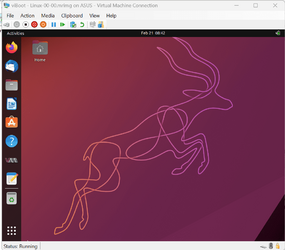- Local time
- 10:18 PM
- Posts
- 5,706
- OS
- Windows 10 Pro + others in VHDs
So I thought I would try something different.
In another post, I showed how I had created a Macrium Reflect image of a stand-alone Linux installation.
It wondered if Viboot would open that image as a Hyper-V VM, so I just tried it.
It did not object during setup, then fell over as it was loading it.
I though "ah well - probably asking too much"/
Then a "light bulb" moment occurred.
I shut down the vm in the Hyper-V menu, and turned off secure boot.
Well flabber my ghast - it booted into Linux.
Cool - eh!
So Viboot will boot non Windows OSs - Rock on!

In another post, I showed how I had created a Macrium Reflect image of a stand-alone Linux installation.
It wondered if Viboot would open that image as a Hyper-V VM, so I just tried it.
It did not object during setup, then fell over as it was loading it.
I though "ah well - probably asking too much"/
Then a "light bulb" moment occurred.
I shut down the vm in the Hyper-V menu, and turned off secure boot.
Well flabber my ghast - it booted into Linux.
Cool - eh!
So Viboot will boot non Windows OSs - Rock on!

My Computer
System One
-
- OS
- Windows 10 Pro + others in VHDs
- Computer type
- Laptop
- Manufacturer/Model
- ASUS Vivobook 14
- CPU
- I7
- Motherboard
- Yep, Laptop has one.
- Memory
- 16 GB
- Graphics Card(s)
- Integrated Intel Iris XE
- Sound Card
- Realtek built in
- Monitor(s) Displays
- N/A
- Screen Resolution
- 1920x1080
- Hard Drives
- 1 TB Optane NVME SSD, 1 TB NVME SSD
- PSU
- Yep, got one
- Case
- Yep, got one
- Cooling
- Stella Artois
- Keyboard
- Built in
- Mouse
- Bluetooth , wired
- Internet Speed
- 72 Mb/s :-(
- Browser
- Edge mostly
- Antivirus
- Defender
- Other Info
- TPM 2.0

















